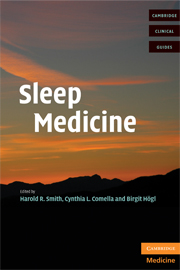Book contents
- Frontmatter
- Contents
- List of contributors
- Foreword
- SECTION 1 NORMAL SLEEP
- SECTION 2 SLEEP DISORDERS
- SECTION 3 SLEEP IN SPECIALTY AREAS
- 9 Sleep and neurologic disorders
- 10 Sleep and psychiatric disorders
- 11 Sleep and medical disorders
- 12 Sleep and pediatrics
- 13 Sleep and geriatrics
- 14 Forensic sleep medicine issues: violent parasomnias
- Index
- References
14 - Forensic sleep medicine issues: violent parasomnias
from SECTION 3 - SLEEP IN SPECIALTY AREAS
Published online by Cambridge University Press: 08 August 2009
- Frontmatter
- Contents
- List of contributors
- Foreword
- SECTION 1 NORMAL SLEEP
- SECTION 2 SLEEP DISORDERS
- SECTION 3 SLEEP IN SPECIALTY AREAS
- 9 Sleep and neurologic disorders
- 10 Sleep and psychiatric disorders
- 11 Sleep and medical disorders
- 12 Sleep and pediatrics
- 13 Sleep and geriatrics
- 14 Forensic sleep medicine issues: violent parasomnias
- Index
- References
Summary
Actus non facit reum nisi mens sit rea – the deed does not make a man guilty unless his mind is guilty
Edward Coke (1552–1634)Introduction
Increasingly, parasomnias are invoked as an explanation for a wide variety of illegal and/or violent behaviors ostensibly arising from the sleep period, with the hope that if such behavior is deemed sleep-related, it may serve to exonerate the perpetrator. In such cases, sleep medicine practitioners are asked to render opinions regarding legal issues pertaining to violent or injurious behaviors purported to have arisen from sleep. Such acts, if having arisen from sleep without conscious awareness, would constitute an “automatism.” Recent advances in the understanding of wake/sleep behaviors and consciousness have made it apparent that some complex behaviors, occasionally violent or injurious with forensic science implications, are exquisitely state-dependent, meaning that they arise exclusively, or predominantly, from the sleep period. They may therefore be without conscious awareness, and therefore possibly without culpability.
It is likely that violence arising from the sleep period is more frequent than previously assumed. One recent survey found that 2% of the adult population report violent behaviors arising from the sleep period.
Case example
AJT was a white male in early adulthood who was the son of a wealthy shoe manufacturer with a factory near Weymouth, Massachusetts. Despite being married with two young daughters, AJT was known to frequently engage in “debauchery” and had been known to squander his affluence in “revelries associated with his aberrant actions.
Keywords
- Type
- Chapter
- Information
- Sleep Medicine , pp. 240 - 255Publisher: Cambridge University PressPrint publication year: 2008



